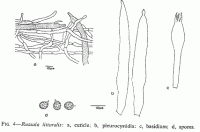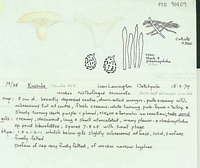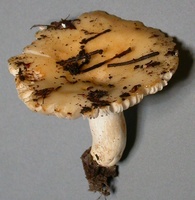|
 Russula littorea Russula littorea
SynonymsRussula littoralis
BiostatusPresent in region - Indigenous. Endemic
Images (click to enlarge) | 
Owner: Greta Stephenson | 
Owner: P. Leonard |
Article: McNabb, R.F.R. (1973). Russulaceae of New Zealand. 2. Russula Pers. ex S.F. Gray. New Zealand Journal of Botany 11(4): 673-730 (http://www.rsnz.org/publish/abstracts.php).
Description: pileus: 3-5.5 cm diam., hemispherical when young, centrally depressed at maturity, slightly viscid under wet conditions, otherwise dry, glabrous, velar remnants absent, pallid creamy white, cream, or creamy ochraceous; margins entire, thick, non-pectinate. Cuticle 250-300 µm thick, composed of ± repent or obliquely ascending, interwoven hyphae and pilocystidia; hyphae thin-walled, septate, 2.5-5 µm diam., terminal cells unspecialised; pilocystidia relatively numerous, often superficial, cylindrical to fusiform, thin-walled, apices acuminate, strangulate, or capitulate, contents refractive in KOH, of variable length, 4-8 µm diam. lamellae: adnate, crowded, moderately thick, simple or forked near stipe, to 4 mm deep, pallid creamy white, not discoloured at maturity, lamellulae numerous, typically in partial sequence. stipe: 2-3.5 cm long, ± equal, 1.2-1.5 cm diam., solid, dry, finely granular-furfuraceous under lens, white to faintly creamy white; flesh white, unchanging on exposure to air. Cuticle similar to that of pileus, caulocystidia often superficial, similar to pilocystidia. spores: spore print not obtained; spores broadly elliptical, obliquely apiculate, apiculus to 1.5-(2) µm long, 7-8.5 X 6-7.5 µm, ornamentation moderately dense, of amyloid verrucae to 0.7 µm high, isolated or joined by fine amyloid ridges and forming a partial reticulum; plage indistinct. hymenium: basidia hyaline, clavate, 44-63 X 8-10.5 µm, 4-spored, sterigmata to 7 µm long; pleurocystidia scattered, extremely numerous, fusiform, hyaline, thin-walled, contents refractive in KOH, projecting to 15 µm beyond basidia, apices acuminate, strangulate, or capitulate, 56-91 X 7.5-10.5 µm, cheilocystidia numerous, similar to pleurocystidia but shorter, hymenophoral trama: heteromerous, intermixed. context of pileus: white, firm, unchanging; structure, heteromerous, clamp connections absent. taste: lamellae acrid, context slightly acrid. chemical characters: formalin on context—n.r.; phenol on context—slowly deep vinaceous; FeSO4 on context—pallid salmon pink; KOH on pileus— darkening slightly; on context—n.r.; NH4OH on pileus and context— n.r.
Habitat: Solitary or in pairs under Leptospermum.
Notes: This species resembles R. papakaiensis in many ways but lamellae do not discolour. Pleurocystidia are more numerous and spores more densely and evenly verrucose.
Article: Pennycook, S.R. (2003). Nomenclatural revisions of New Zealand agarics and boletes. New Zealand Journal of Botany 41(3): 501-502 (http://www.rsnz.org/publish/abstracts.php).
Description: In a final paper published after his premature death in 1972, New Zealand mycologist Ross
McNabb described 32 new endemic species of the genus Russula (McNabb 1973). All of these
continue to be accepted as distinct taxa, but three of his names,Russula atrovirens, R.
littoralis, and R. rimosa, are homonyms of earlier names, and are thus nomina illegitima,
requiring new names. The first of the three was renamed by Buyck (1990) [as Russula atroviridis, for R. atrovirens]; the other two
are renamed here.
Russula littorea Pennycook, nom. nov. ç
Russula littoralis McNabb, N.Z. J. Bot. 11,
681 (1973), nom. illegit., non Romagn. 1972 (nec Pegler 1980, nom. illegit.).
ETYMOLOGY: referring to the seashore type locality, Bethell's Beach, Auckland.
|